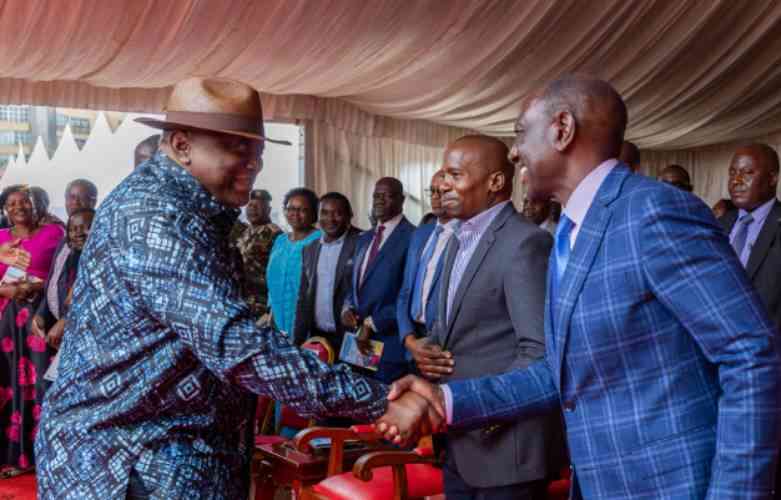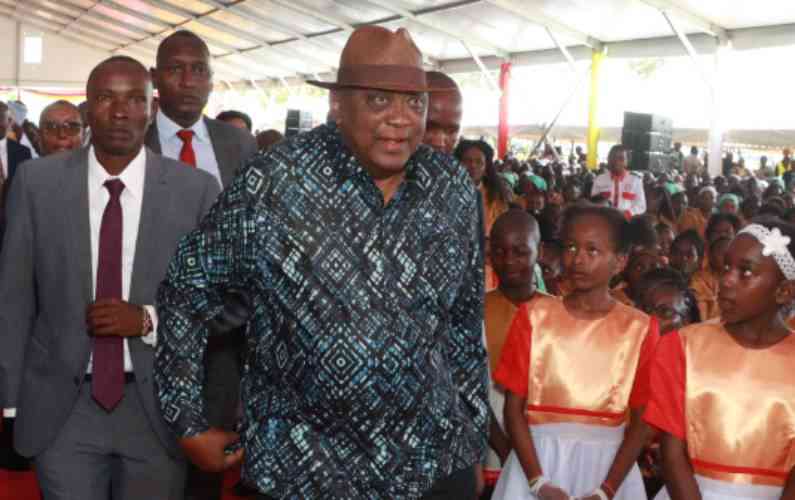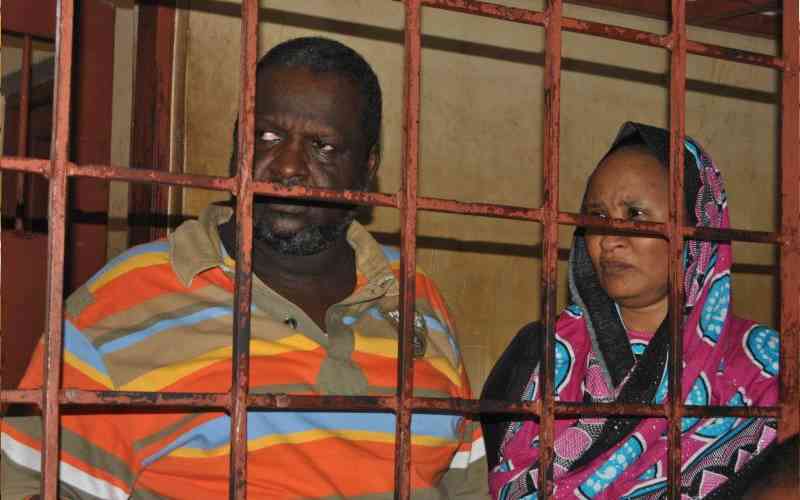The body of former President Moi rested under watchful eyes of independent Kenya’s Speakers as the mighty and the low, rich and poor filed past him in honour.
Led by President Uhuru Kenyatta and his Cabinet, 24,863 men and women walked into Parliament chambers to view the body of a man who bestrode the country like a colossus and left deep imprints all over it.
Before that, a heavy-hearted Kenyatta, faced the nation for the first time since his arrival from the United States to pose a rhetorical but immortal question: “How does one mourn an iconic leader?”
At the State House address, the President’s face, tone of his voice and the sorrowful setting around him clearly captured the intensity of the moment; the loss of an iconic leader, a mentor and, some would say, a second father to him.
Having lost his father - founding President Jomo Kenyatta- in 1978 in his teenage, the late President Moi picked him up, saw him through education, marriage, career and finally made him a President.
“How is a man who achieved so much more than is expected in a lifetime - be celebrated?” Uhuru posed yet again.
In Parliament, and at the four corners of the dark green silver laced platform where Mzee’s body lay, four military colonels in formal clad stood unflinching, facing away from their ex-commander in chief.
Championed policies
The portraits of the five men who have presided over Parliament over the years- Justin Muturi, Kenneth Marende, Francis ole Kaparo, Jonathan Ng’eno Moses Keino and Fred Mati towered above Mzee’s body.
At exactly 10.19am, President Kenyatta walked into the parliamentary lobby, accompanied by the First Lady, Margaret Kenyatta and was received by Deputy President William Ruto before they slowly marched to where his mentor lay in state. Moi’s family had arrived earlier at around 9.43 am.
They comprise Baringo Senator Gideon Moi, Rongai MP Raymond Moi, Phillip Moi, John Mark, Jenifer Moi, Doris Moi and June Moi, their spouses and children. Jonathan Moi passed on last year.
It was in this same corridor that the former Head of State walked on numerous occasions as the longest serving MP, Vice President, and President as he championed policies and programs that ensured that he followed the footsteps of his predecessor, Mzee JKenyatta.
Just as the Head of State arrived, the snow white curtain that had been hang around the ‘bed’ where the former President lay was removed to reveal the man who had dedicated his whole life to serving his country.
“What would be a befitting send off or national honour for a man who built Kenya, in large part by the works of his hands?” Uhuru posed at State House.
Stay informed. Subscribe to our newsletter
Before his mentor, Uhuru alongside the First Lady paused, stared at the Moi’s face, respectfully bowed and quietly walked away. In 1978, Moi had led the country in viewing the body of his father, Mzee Kenyatta. Now, the younger Kenyatta was returning the gesture.
“How else can a grateful nation celebrate the life of a man whose calm and steady hand reassured a young nation and her allies, during the peaceful transition into the Second Administration?” the President had exhorted in his earlier briefing.
In the background, three choirs among them St Stephens ACK church Choir, Jogoo Road belted out some somber songs among them Pokea Moyo Wangu, further completing the 1978 when similar tunes were belted for Mzee Kenyatta.
The military band also performed a number of songs including Abide With Me, which was one of Moi’s favorites. Together with the choirs, the military took turns in singing for the mourners.
Daniel Madalanga, 53, who was directing the St Stephen Choir recalled how he sang at the funeral of the founding President in 1978 when he was only 12. Rahab Mwangi, in her 70s and a member of St Andrews Choir also sang in the choir in 1978.
After doing her duty as a choir member yesterday, Rahab with the assistance of a cane also entered the lobby where she viewed former President Moi’s body and eventually left the premises to go home and await a call to return when her choir was required at Parliament.
It was in keeping with Moi’s philosophy of simplicity that the mighty and low mingled freely with the military and the clergy as they filed past his body. Some came in their every day clothes like the chef who is a member of the parliamentary staff who was wearing his white headgear and apron.
Another worker wearing a white apron, first smoothed the carpet for the VIP, tucking it with nails before he stashed his hammer and cell tape into his backpack and patiently lined up to pay respect to the former Head of State.
The Cabinet Secretaries led by Fred Matiang’i escorted the President in paying respect to Mzee Moi. The judiciary led by Deputy Chief Justice Philomena Mwilu and Parliament led by the two Speakers- Muturi and Ken Lusaka led their respective Houses.
Former Maendeleo Ya wanawake Chairperson, Zipporah Kittony was overwhelmed by grief and had to be supported by her son Kiprono Kittony. She had first viewed the body and rested in a holding room reserved for the family before she returned accompanied by her son and another relative.
She looked at the former President’s body and then raised both hands, waved slowly as if saying goodbye and stood still before she was led away.
Every so often the four colonels would be relieved by a fresh quartet, drawn from the Kenya Army, the Navy, and Air Force. The former commander in chief was never alone.
This was the second time the remains of a dignitary were being viewed at Parliament buildings. The first body to be brought to Parliament for viewing was that of the then Vice President, Michael Wamalwa Kijana who died in office in 2003.
Kenyatta’s body was placed at State House, where it stayed for ten days as Kenyans and other world leaders paid their respects.
Earlier on at the State House event, Uhuru fiddled with his fingers and flashed gazes at the camera as he churned out one adjective after another- over 20 of them- in describing Mzee Moi.
On his sides, the Cabinet dressed in uniform colors looked forlorn. The only visible movement were the flags behind him that gently swayed from side to side.
He grappled with words as he sought to paint a picture of the leader whose 24-year rule saw major developments in the country, peace and unity as espoused in his Nyayo philosophy of following in the footsteps of Mzee Kenyatta.
“A leader who spent almost his entire life in service to our Nation, whose story of heroism, sacrifice and service, began in the pre-independence era.”
He decorated Moi as a “cherished brother, a loving father, a mentor to many, a father of our Nation, a champion of Pan-Africanism, and the Second President of the Republic of Kenya”. His distinct leadership attributes earned him a legacy that will last to eternity, he said.
As the sun edged closer to the horizon to set, the military regrouped once again, and ferried the body back to Lee for the night.
 The Standard Group Plc is a
multi-media organization with investments in media platforms spanning newspaper
print operations, television, radio broadcasting, digital and online services. The
Standard Group is recognized as a leading multi-media house in Kenya with a key
influence in matters of national and international interest.
The Standard Group Plc is a
multi-media organization with investments in media platforms spanning newspaper
print operations, television, radio broadcasting, digital and online services. The
Standard Group is recognized as a leading multi-media house in Kenya with a key
influence in matters of national and international interest.
 The Standard Group Plc is a
multi-media organization with investments in media platforms spanning newspaper
print operations, television, radio broadcasting, digital and online services. The
Standard Group is recognized as a leading multi-media house in Kenya with a key
influence in matters of national and international interest.
The Standard Group Plc is a
multi-media organization with investments in media platforms spanning newspaper
print operations, television, radio broadcasting, digital and online services. The
Standard Group is recognized as a leading multi-media house in Kenya with a key
influence in matters of national and international interest.









